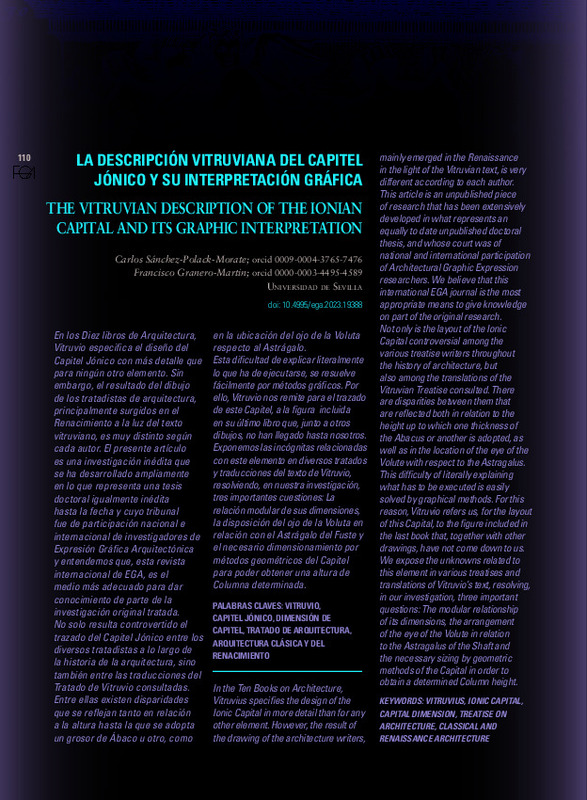|
Resumen:
|
[EN] In the Ten Books on Architecture, Vitruvius specifies the design of the Ionic Capital in more detail than for any other element. However, the result of the drawing of the architecture writers, mainly emerged in the ...[+]
[EN] In the Ten Books on Architecture, Vitruvius specifies the design of the Ionic Capital in more detail than for any other element. However, the result of the drawing of the architecture writers, mainly emerged in the Renaissance in the light of the Vitruvian text, is very different according to each author. This article is an unpublished piece of research that has been extensively developed in what represents an equally to date unpublished doctoral thesis, and whose court was of national and international participation of Architectural Graphic Expression researchers. We believe that this international EGA journal is the most appropriate means to give knowledge on part of the original research. Not only is the layout of the Ionic Capital controversial among the various treatise writers throughout the history of architecture, but also among the translations of the Vitruvian Treatise consulted. There are disparities between them that are reflected both in relation to the height up to which one thickness of the Abacus or another is adopted, as well as in the location of the eye of the Volute with respect to the Astragalus. This difficulty of literally explaining what has to be executed is easily solved by graphical methods. For this reason, Vitruvio refers us, for the layout of this Capital, to the figure included in the last book that, together with other drawings, have not come down to us. We expose the unknowns related to this element in various treatises and translations of Vitruvio' s text, resolving, in our investigation, three important questions: The modular relationship of its dimensions, the arrangement of the eye of the Volute in relation to the Astragalus of the Shaft and the necessary sizing by geometric methods of the Capital in order to obtain a determined Column height.
[-]
[ES] En los Diez libros de Arquitectura, Vitruvio especifica el diseño del Capitel Jónico con más detalle que para ningún otro elemento. Sin embargo, el resultado del dibujo de los tratadistas de arquitectura, principalmente ...[+]
[ES] En los Diez libros de Arquitectura, Vitruvio especifica el diseño del Capitel Jónico con más detalle que para ningún otro elemento. Sin embargo, el resultado del dibujo de los tratadistas de arquitectura, principalmente surgidos en el Renacimiento a la luz del texto vitruviano, es muy distinto según cada autor. El presente artículo es una investigación inédita que se ha desarrollado ampliamente en lo que representa una tesis doctoral igualmente inédita hasta la fecha y cuyo tribunal fue de participación nacional e internacional de investigadores de Expresión Gráfica Arquitectónica y entendemos que, esta revista internacional de EGA, es el medio más adecuado para dar conocimiento de parte de la investigación original tratada. No solo resulta controvertido el trazado del Capitel Jónico entre los diversos tratadistas a lo largo de la historia de la arquitectura, sino también entre las traducciones del Tratado de Vitruvio consultadas. Entre ellas existen disparidades que se reflejan tanto en relación a la altura hasta la que se adopta un grosor de Ábaco u otro, como en la ubicación del ojo de la Voluta respecto al Astrágalo. Esta dificultad de explicar literalmente lo que ha de ejecutarse, se resuelve fácilmente por métodos gráficos. Por ello, Vitruvio nos remite para el trazado de este Capitel, a la figura incluida en su último libro que, junto a otros dibujos, no han llegado hasta nosotros. Exponemos las incógnitas relacionadas con este elemento en diversos tratados y traducciones del texto de Vitruvio, resolviendo, en nuestra investigación, tres importantes cuestiones: La relación modular de sus dimensiones, la disposición del ojo de la Voluta en relación con el Astrágalo del Fuste y el necesario dimensionamiento por métodos geométricos del Capitel para poder obtener una altura de Columna determinada.
[-]
|









